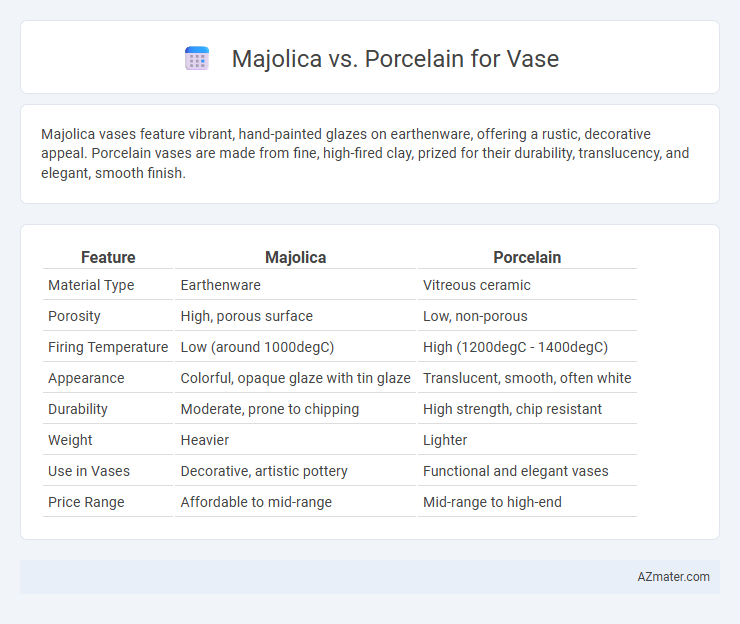Majolica vases feature vibrant, hand-painted glazes on earthenware, offering a rustic, decorative appeal. Porcelain vases are made from fine, high-fired clay, prized for their durability, translucency, and elegant, smooth finish.
Table of Comparison
| Feature | Majolica | Porcelain |
|---|---|---|
| Material Type | Earthenware | Vitreous ceramic |
| Porosity | High, porous surface | Low, non-porous |
| Firing Temperature | Low (around 1000degC) | High (1200degC - 1400degC) |
| Appearance | Colorful, opaque glaze with tin glaze | Translucent, smooth, often white |
| Durability | Moderate, prone to chipping | High strength, chip resistant |
| Weight | Heavier | Lighter |
| Use in Vases | Decorative, artistic pottery | Functional and elegant vases |
| Price Range | Affordable to mid-range | Mid-range to high-end |
Introduction to Majolica and Porcelain Vases
Majolica vases are characterized by their vibrant, lead-glazed earthenware, often featuring intricate hand-painted designs that highlight rich colors and glossy finishes. Porcelain vases, made from refined kaolin clay fired at high temperatures, exhibit delicate translucency, strength, and smooth, white surfaces ideal for both minimalist and ornate styles. The distinct material properties of majolica and porcelain influence their durability, aesthetic appeal, and suitability for decorative versus functional vase uses.
Historical Origins and Evolution
Majolica originated during the Renaissance in 15th-century Italy, renowned for its vibrant tin-glazed earthenware that emphasized detailed, colorful designs. Porcelain emerged later in 7th-century China, celebrated for its translucent, durable qualities achieved through high-temperature firing of kaolin clay. Over centuries, Majolica evolved in European studios with rich ornamentation, while porcelain spread globally, influencing fine ceramics with its refined texture and strength.
Material Composition and Manufacturing Process
Majolica vases are crafted from earthenware clay with a porous body, coated in a tin-based glaze that produces a brightly colored, opaque finish after kiln firing at lower temperatures around 1,000degC. Porcelain vases consist of kaolin clay combined with feldspar and quartz, fired at higher temperatures between 1,200degC and 1,400degC to achieve a dense, non-porous, and translucent quality. The manufacturing process of Majolica involves hand-painting vibrant designs on the glaze surface, while porcelain typically undergoes precise molding and glazing to create smooth, refined finishes.
Visual Aesthetics and Artistic Appeal
Majolica vases are renowned for their vibrant, hand-painted glazes and intricate, colorful designs that create a lively and rustic aesthetic, making each piece visually striking and unique. Porcelain vases offer a smooth, translucent surface with a refined, elegant finish, often featuring delicate, detailed artwork that emphasizes sophistication and subtlety. The choice between Majolica and porcelain hinges on the desired artistic appeal: bold and expressive versus minimalist and graceful.
Durability and Functional Qualities
Majolica vases, crafted from earthenware clay and glazed for vibrant finishes, tend to be less durable than porcelain due to their porous nature and lower firing temperatures. Porcelain vases are fired at higher temperatures, resulting in a dense, non-porous, and highly durable material resistant to chipping and cracking, making them ideal for long-term functional use. The superior strength and moisture resistance of porcelain enhance its suitability for holding water and maintaining floral arrangements without damage over time.
Typical Uses for Majolica vs Porcelain Vases
Majolica vases are traditionally used for decorative purposes, often featuring vibrant, hand-painted glaze that showcases intricate floral or natural motifs, making them ideal for accent pieces in living spaces or garden displays. Porcelain vases, prized for their strength, translucence, and classic white finish, are commonly employed for both functional floral arrangements and elegant interior decor, fitting seamlessly into formal settings or minimalist designs. While Majolica emphasizes artistic expression and rustic charm, porcelain vases prioritize durability and timeless sophistication in everyday or ceremonial use.
Care, Maintenance, and Preservation Tips
Majolica vases require gentle cleaning with a soft cloth and mild soapy water to avoid damaging their vibrant tin-glazed surfaces, while porcelain vases benefit from regular dusting and occasional washing with non-abrasive cleaners to maintain their smooth, glossy finish. Both materials should be displayed away from direct sunlight and extreme temperature changes to prevent fading or cracking. Storing Majolica and porcelain vases in stable environments with controlled humidity levels preserves their integrity and extends their lifespan.
Value and Collectibility in the Market
Majolica vases, known for their vibrant glazes and intricate designs, generally hold higher value and collectibility due to their historical significance and artisanal craftsmanship, appealing strongly to collectors of antique pottery. Porcelain vases, prized for their delicate translucence and refined finish, maintain consistent market demand and often fetch premium prices, especially when featuring rare markings or originating from renowned manufacturers. Both materials command substantial interest, but Majolica's unique aesthetic and limited production periods typically enhance its desirability and resale value in the collectibles market.
Environmental Impact and Sustainability
Majolica vases, made from earthenware with a lead-based glaze, often involve higher environmental impacts due to the use of toxic materials and energy-intensive firing processes. Porcelain vases, crafted from kaolin clay and fired at higher temperatures, tend to have greater durability and longer lifespans, promoting sustainability through resistance to chipping and reduced need for replacement. Both materials require careful disposal, but porcelain's inert composition lessens environmental harm over time compared to the chemical leaching risks associated with majolica glazes.
Final Comparison: Choosing the Best Vase for Your Needs
Majolica vases offer vibrant, hand-painted designs with a porous surface ideal for decorative purposes, while porcelain vases provide a sleek, non-porous finish that excels in durability and water resistance for practical use. For collectors prioritizing artistic appeal and unique craftsmanship, Majolica is the preferred choice, whereas porcelain suits those seeking longevity and ease of maintenance. Selecting the best vase depends on whether aesthetic value or functional performance aligns more closely with your specific needs.

Infographic: Majolica vs Porcelain for Vase
 azmater.com
azmater.com